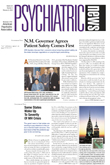In this era of the Human Genome Project, questions of “nature vs. nurture” are increasingly being met with definitive answers that insist the cliché be reworded to “nature plus nurture.”
An intriguing recent study, little noted in the popular press, determined that schizophrenia was 81 percent genetic and 11 percent environmental—give or take a few percentage points, of course.
Quantifying the genetic and environmental contributions to major disorders is an increasingly popular task of genetic researchers; however, few (if any) reports have attempted to determine so precisely the components for serious and persistent mental illness. Previous reports of genetic-environmental interactions in mental illness have focused more on qualitative and descriptive terms. The report of more than an 80 percent genetic component to schizophrenia appears to change that status quo.
The new study, funded by the National Institute of Mental Health, was conducted by Patrick Sullivan, M.D., a professor of genetics and psychiatry at the University of North Carolina at Chapel Hill, and his colleagues at the Virginia Institute for Psychiatric and Behavioral Genetics. Their findings appeared in the December 2003 Archives of General Psychiatry.
Dozen Twin Studies Analyzed
Sullivan and his colleagues performed a quantitative meta-analysis of 12 published twin studies of schizophrenia and not surprisingly confirmed the studies’ claims that schizophrenia is a complex, multigene trait that is highly heritable.
However, the Sullivan report appears to be the first to quantify the risk of developing schizophrenia as being 11 percent environmental. Along with the 81 percent genetic contribution, that leaves just 8 percent to the “we don’t know” margin of error.
Sullivan’s group searched the literature for studies of schizophrenia in twins. They found 14 reports, but discounted two of those in their analysis because they did not use systematic recruitment and were not blinded as to whether the twins were monozygotic or dizygotic.
The dozen studies included in the meta-analysis were published from 1941 to 1999 and conducted by researchers mainly in Europe or the United States.
The authors of the meta-analysis are quick to note that the quality of the methods used in the 12 studies “was not uniformly high.” For example, most studies “did not include several critical features (blinding or a standardized diagnostic approach) that are generally viewed as central to the interpretability of twin studies of medical disorders.” Sullivan noted, however, that several of the studies were completed before these standards were recognized.
To gain the maximum benefit of the largest sample size, Sullivan and his co-authors included the lower-quality studies in the analysis and calculated whether they yielded a different estimate than if they used only the higher-quality twin studies.
Heterogeneity Was a Natural
In addition to problems with methodology, Sullivan noted, the 12 studies were statistically heterogeneous.
His group calculated statistical point estimates for both genetic and environmental components for each of the 12 studies. Genetic component estimates ranged from about 25 percent to 95 percent, while environmental components ranged from close to zero up to about 70 percent. This wide heterogeneity among the studies created concern over the significance of the overall estimates derived by the meta-analysis.
Remarkably, regardless of the quality of methods used in the original twin studies, and in spite of the high degree of heterogeneity, Sullivan and his colleagues found that both nature and nurture remained consistent.
“Critically, when we compared the methodologically superior studies with the methodologically inferior studies,” the researchers pointed out, “we found similar point estimates for additive genetic effects (77 percent vs. 78 percent) and common environmental effects (17 percent vs. 14 percent).”
The high degree of heterogeneity could likely have resulted, the authors concluded, from differences in the study samples, including differences in male-female or monozygotic-dizygotic ratios.
X + Y = Schizophrenia
“However, it is also possible,” they suggested, “that there exists true variation in the etiology of schizophrenia during the decades spanned by these studies or across the different countries and ethnic ancestries of the individuals in these studies.”
Indeed, season of birth, prenatal exposure to viral infections, and maternal food supply—all of which have been linked to schizophrenia risk—would be expected to vary significantly across the 12 studies.
Sullivan and his co-authors concluded that while schizophrenia is overwhelmingly an inherited disorder, the environmental component of its development is highly likely to occur early in life, which would be consistent with current theories that schizophrenia arises from a neurodevelopmental etiology.
“The environments of members of twin pairs tend to diverge over time,” they stressed, noting that the environment is “most similar in utero and in the immediate postnatal period, with increasing divergence over infancy, childhood, adolescence, and adulthood.”
Their results, Sullivan and his co-authors said, “provide a component of a unifying empirical basis for supporting the rationality of searches for underlying genetic and common environmental etiological factors.”
Arch Gen Psychiatry 2003 60 1187
